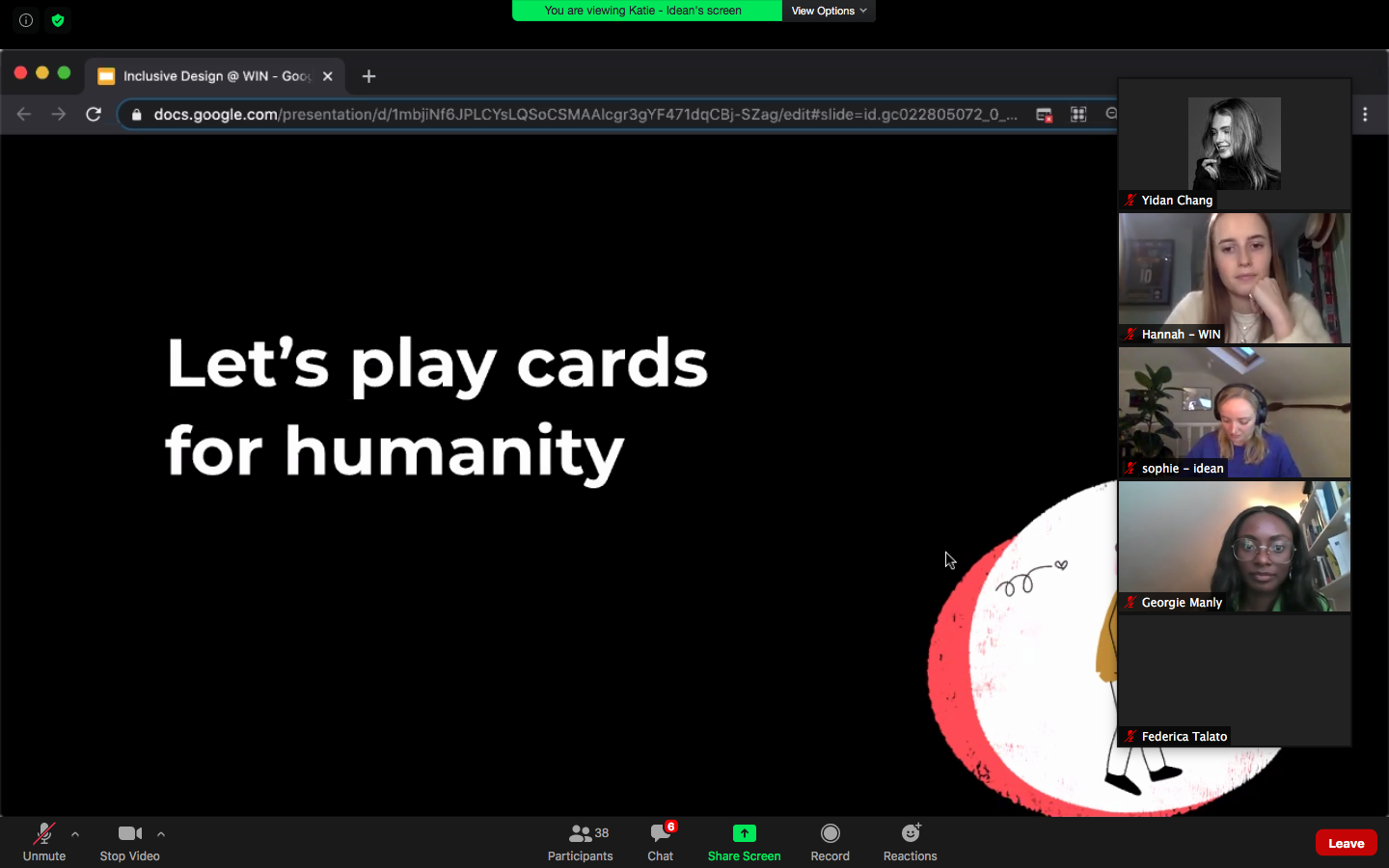WINSight: Cards for Humanity
Even with the world on pause, the pace of the past year has felt undeniably fast. Our everyday experiences have become truly digital for the very first time. But as businesses feel the pressure to adapt, be agile and remain relevant, they risk leaving people behind.
In principle, we recognize the acute need to develop products and services that fulfill diverse needs and are accessible to everyone. But as innovators, we know the reality can be much more challenging to achieve and even harder to prioritize.
In late February, WIN LDN partnered with global design studio Idean to show just how we can make this possible. Experts in inclusive thinking, through a virtual workshop, the team at Idean shared with us their Cards for Humanity, a practical tool to help embed inclusive design into products, services, and user journeys. In this interactive session, attendees worked together to wholly reimagine how different users might experience the world around them using the cards to solve for inclusivity.
But what is inclusive design?
At the heart of it, inclusive design is defined as;
“The creation of mainstream products and/or services that are accessible to, and usable by, as many people as reasonably possible no matter their situation or context.” - Idean
We say as many as reasonably possible because the number of people who could benefit from more inclusive design is undefinable. Those living with some form of disability are by no means a minority. Yet countless more individuals live with temporary and situational impairments that may profoundly affect their ability to engage with and benefit from essential everyday products and services.
Ultimately, inclusive design is a process. It requires constant learning, re-evaluating, and educating ourselves on the lived experiences of others. Although inclusive design isn’t just about designing for a diversity of impairments, there is also a diversity of perspectives. The breadth and depth of human experience impact how individuals interact with the world, including their products and services. Inclusive design requires a mindset shift. It means understanding that solving for the few benefits the many, creating experiences that are universally valuable and accessible.
Putting inclusive design into practice with Cards for Humanity
In this virtual world, WIN was thrilled to collaborate with Idean, having recently launched their Cards for Humanity online. Bringing together our WIN members worldwide, the cards helped uncover new ways of thinking and testing products, services, and user journeys from limitless perspectives.
How it works:
Attendees were presented with two different cards – one describing a user and the other detailing a diverse range of needs.
In different combinations, the cards put forward different scenarios to test a product or service. Together, our attendees discussed what a certain scenario could mean for a particular persona and brainstormed new ways to design a more inclusive user experience with them in mind.
Imagine you work for a bank, or a supermarket or a national transport service. Although many of us will have largely seamless and stress-free experiences when we interact with these businesses, for others, this isn’t the case.
For example, Alex, aged 49, is shy and partially sighted. Opening a new account, placing an online food order, or signing up for a travel card are essential to the way we live today but present a whole host of hurdles and challenges for Alex that many others may take for granted.
Instead, how might you design a more inclusive user journey for Alex that feels accessible throughout every touchpoint?
What about Kristen, who is 22 years old, anxious, and hates talking over the phone? How might we foster a sense of belonging and inclusion for Kristen too?
And for Tessa, aged 66, who is outgoing and has frequent migraines? How might we design a more inclusive user journey now for Tessa?
There are countless ways that the products and services that exist in our lives today can better exist in the lives of others too. Cards for Humanity is one way to help us do this by challenging our assumptions about traits, exposing unconscious bias, and adding greater depth to how we think about our users and their lives.
“I found Cards for Humanity really good for building empathy for the persona and building on each other’s ideas.” – Workshop attendee
Pitching inclusive design as a priority with Universal Score
As Cards for Humanity shows, inclusive design is a must for any organization. But in reality, it can be hard to prioritize, an afterthought left until the very end when it’s typically too late.
As part of the workshop, WIN attendees received a sneak peek at Idean’s brand new tool, Universal Score. Adjacent to Cards for Humanity, this framework helps product teams think about inclusive design at every stage of their process by evaluating how inclusive an experience or user journey is.
The benefits of this are two-fold: the framework identifies the areas of opportunity for a product or service to be improved and provides a critical, objective, and comparative measure of inclusivity.
As innovators, we’re advocates of more inclusive thinking, but organizational structures and realities often mean our ambitions fall short. Our new challenge is making inclusive design the priority and leading with inclusivity the norm. By evaluating inclusivity against a set of criteria, Universal Score highlights the benefits of adopting an inclusive mindset from day one for both your end-users and your bottom line.
Inclusive design might be a win-win, but achieving buy-in from other stakeholders can be vital in pushing through an idea for greater inclusion from inception to execution. Communication is key, and with this in mind, our attendees created 30-second pitches to help get inclusive design prioritized in their organizations. Have a go for yourself.
Ask yourself;
1. What’s getting in the way?
2. What business impact would being more inclusive have?
3. What’s your 30-second pitch?
By defining what successful design looks like to us, others, and most importantly, our users, we stand a better chance at embedding inclusivity in every stage of the process and creating the optimum user experience for the greatest number of people possible.
How well are you designing for inclusion and belonging? Find out here!
Let’s face it – digital is going nowhere. With inclusive thinking now in our toolkits, we hold the power to unlock opportunities and new experiences for everyone. And in designing products and services that are accessible, inclusive, and user-friendly, we all benefit from being at the forefront of innovation.
Thank you once again to Valeria Adani, Katie Wyburd, Charlotte Fereday, and Charlie Wileman from Idean for the incredible workshop. We took so much away from it, and we want to thank our WIN community for their passion and participation.
Editorial by Lucia Corry
WIN: Women in Innovation Copyright (c) 2020 All rights reserved. This content may not be further reproduced or repurposed without written permission from WIN: Women in Innovation (501(c)3). This blog post is provided for your personal use only.




